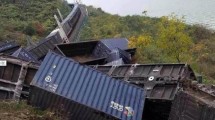Abstract
High-speed railway engineering in mountainous areas suffers from occasional poor geological conditions, rugged topography, and complex hydrographic conditions. It is an important means of ensuring its safe operation to conduct real-time remote monitoring and analysis of the subgrade structure condition. Through analysing the stress characteristics of the mountainous subgrade, a complete monitoring system has been built and a corresponding software platform for datum acquisition and analysis has also been developed. After selecting a typical mountainous high-speed railway subgrade located in Hunan Province as the test section, the real-time monitoring of the subgrade structure in a static settling period, joint commissioning period, and an operational period was conducted and the primary condition datum was obtained. It is found that the dynamic response parameters have relatively slow attenuation velocities and the influencing depth of the high-speed train loads was about 4–5 m; when the structural state of the mountainous subgrade is healthy, subgrade deformations are small and, compared with the dynamic response datum of the subgrade in plain areas, the dynamic response of the mountainous high-speed railway subgrade was consistent. However, the long-term dynamic response and deformation of such mountainous subgrades still needs to be monitored, and analysed, continually.


























Similar content being viewed by others
References
Bian XC, JIANG HG, Cheng C et al (2014a) Full-scale model testing on a ballastless high-speed railway under simulated train moving loads. Soil Dyn Earthq Eng 66:368–384
Bian XC, Jiang HG, Cheng C et al (2014b) Full-scale model testing on a ballastless high-speed railway under simulated train moving loads. Soil Dyn Earthq Eng 66:368–384
Chen SX, SONG J, ZHOU QN et al (2010) Theory and practice for high-speed railway settlement and deformation observation and evaluation. China Railway Publishing House, Beijing
Feng SM, Lei XY, Zhang PF et al (2011) The remote monitoring and analysis of additional contractility from the CWR on bridge. J East China Jiaotong Univ 28(2):1–5
Feng Q, Zhang Y, Zhu N et al (2013) Design of remote rail time monitoring system based on GPRS for railway roadbed subsidence. J Geodesy Geodyn 33(3):155–157
Hashash YMA, Marulanda C, Ghaboussi J et al (2006) Novel approach to integration of numerical modeling and field observations for deep excavations. J Geotech Geoenviron Eng 132(8):1019–1031
He MC (2009) Real-time remote monitoring and forecasting system for geological disasters of landslides and its engineering application. Chin J Rock Mech Eng 28(6):1081–1090
He MC, Cui ZQ, Jiang Y, Jiang WB, Yao AJ (1999) Study on 3S engineering analysis system of the slope stability in the Three-gorges. J Eng Geol 7(2):113–117
He MC, Zhang JF, Heng CY, Mao LQ (2004) Research on critical inclination of cut slope of expansive soft rock in Yanbian region. J Liaoning Tech Univ 23(1):55–56
He MC, Tao ZG, Zhang B (2009) Application of remote monitoring technology in landslides in the Luoshan mining area. Min Sci Technol 19(5):610–614
Lei XY (2015) High speed railway track dynamics: model, algorithm and application. Science Press, Beijing
Li J (2013) On dynamic response of the red clay foundation under high-speed train loading. Institute of Rock and Soil Mechanics, Chinese Academy of Sciences, Wuhan
Nie ZH (2005) Study on vertical dynamic response of the track/subgrade in high-speed railway. Central South University, Changsha
Spencer BF, Gao Y, Yang G (2005) Distributed computing strategy for damage monitoring employing smart sensors. In: Proceedings of the Second International Conference on Structural Health Monitoring and Intelligent Infrastructure, Shenzhen, China, vol 11, pp 16–18
Wang L, Jin HH, Luo Z et al (2013) Probabilistic back analysis of slope failure—a case study in Taiwan. Comput Geotech 51:12–23
Wang L, Luo Z, Xiao J et al (2014) Probabilistic inverse analysis of excavation-induced wall and ground responses for assessing damage potential of adjacent buildings. Geotech Geol Eng 32(32):273–285
Wu K, Sheng Q, Zhang YH et al (2010) Development of real-time remote monitoring and forecasting system for geological disaster at subgrade slopes of mountainous highways and its application. Rock Soil Mech 31(11):3683–3687
Xie HC (2009) A new technology for structural health monitoring: smart sensor networks. J Sichuan Univ Sci Eng (Natural Science Edition) 22(4):1–3
Xu LK, Li SH, Liu XY et al (2007) Application of real-time telemetry technology to landslide in Tianchi Fengjie of Three Gorges. Chin J Rock Mech Eng 26(S2):4477–4483
Yang Q, Feng QB, Zhang B et al (2012) An automatic method and system for measuring and monitoring subgrade settlement using inclinometer. J Beijing Jiaotong Univ 36(6):52–56
Yang J, Feng QB, Gao Z et al (2014) On a method and system for automatically monitoring key parameters of railway subgrade. Acta Geodaetica Cartogr Sin 6:24–28
Yang X, Hou D, Tao Z et al (2015) Stability and remote real-time monitoring of the slope slide body in the Luoshan mining area. Int J Min Sci Technol 25:761–765
Ye Y, Mu QX, Zhang CP (2009) Tunnel construction multivariate information forewarning and safety management system research. Chinese J Rock Mech Eng 28(5):900–907
Zhai WM, Wei K, Song XL et al (2015) Experimental investigation into ground vibrations induced by very high speed trains on a non-ballasted track. Soil Dyn Earthq Eng 72:24–36
Zhang CP, Zhang DL, Luo JJ et al (2009) Remote monitoring system applied to the construction of metro station undercrossing existing metro tunnel. Rock Soil Mech 30(6):1861–1866
Zhang LL, Zhang J, Zhang LM et al (2010) Back analysis of slope failure with Markov chain Monte Carlo simulation. Comput Geotech 37(7–8):905–912
Acknowledgements
Financial support from the Natural Science Foundation of Hubei Province (Grant No. 2015CFB363) is gratefully acknowledged.
Author information
Authors and Affiliations
Corresponding author
Rights and permissions
About this article
Cite this article
Li, J., Chen, S., Yu, F. et al. Remote monitoring for a high-speed railway subgrade structure state in a mountainous area and its response analysis. Bull Eng Geol Environ 77, 409–427 (2018). https://doi.org/10.1007/s10064-016-0965-4
Received:
Accepted:
Published:
Issue Date:
DOI: https://doi.org/10.1007/s10064-016-0965-4




